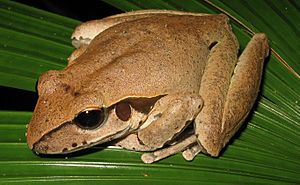Jungguy frog facts for kids
Quick facts for kids Jungguy frog |
|
|---|---|
 |
|
| Conservation status | |
| Scientific classification | |
| Genus: |
Ranoidea (genus)
|
| Species: |
jungguy
|
| Synonyms | |
|
|
The jungguy frog (Ranoidea jungguy) is a fascinating tree frog that makes its home in Australia. You can find this special frog living in the warm, wet state of Queensland.
Contents
About the Jungguy Frog
The jungguy frog is a type of tree frog, meaning it spends most of its life in trees and plants. These frogs are known for their ability to climb using special sticky pads on their toes.
Where Jungguy Frogs Live
These amazing frogs prefer to live in rainforests. They are often found near the Barron River and stretching east towards the Mirray River. Some jungguy frogs also live close to the Broken River. These areas provide the perfect damp and green environment for them to thrive.
What Jungguy Frogs Look Like
Jungguy frogs are not very big. An adult male frog is usually about 3.1 to 4.8 centimeters long. That's about the length of a small paperclip! Female frogs are a bit larger, measuring from 4.4 to 7.1 centimeters.
Their skin is typically a light brown color, often with darker brown patterns or marks. This helps them blend in with their surroundings, like tree bark or leaves. Interestingly, during mating season, some male frogs might even turn partly yellow. This bright color helps them attract female frogs.
Special Features
The jungguy frog has some cool features that help it survive. Its front feet do not have webbing, which is common in many frogs. Instead, they have large, round discs on their toes. These discs act like suction cups, helping the frog grip onto surfaces as it climbs trees and plants.
Life Cycle and Reproduction
The way jungguy frogs lay their eggs is quite unique! Instead of just laying them in open water, they are known to dig a special spot.
Digging an Egg Basin
In some places, a female jungguy frog will dig a small, shallow basin in the ground. This basin acts like a tiny nursery for her eggs. The tadpoles, which are baby frogs, will stay safe in this basin until they grow big enough to become frogs.
The frog carefully chooses a spot for this basin. It needs to be in sandy ground where some sunlight can reach through the trees. It also needs to be close enough to a stream or water source. This way, water can slowly seep through the sand into the basin, keeping the eggs and tadpoles moist.
Mating Habits
Scientists have observed that in some frog species, the male frog digs a basin to impress a female. However, with the jungguy frog, researchers believe it's different. They think the male frog first attracts a female, and only then do they work together or the female digs the basin for their eggs. This shows how different frog species can have unique ways of reproducing.
Scientific Discoveries
For a long time, scientists thought the jungguy frog was the same species as another frog called Litoria lesueuri. But with more research and careful study, they realized that the jungguy frog is its own distinct species. This is a great example of how science is always learning new things and updating our understanding of the natural world!


